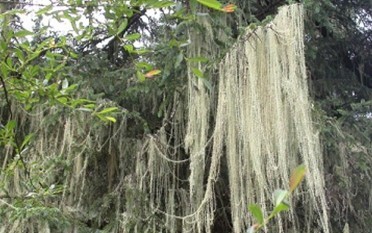Usnea is the generic and scientific name for several species of lichen in the family Parmeliaceae, that generally grow hanging from tree branches, resembling grey or greenish hair. Usnea Diffracta is not a plant but rather a fruticose lichen combination of two kinds of organisms, fungus and alga, growing in a symbiotic union. Some Usnea species reproduce by soredia, whereby a moldlike fungus captures and entraps microscopic green algae, resulting in a new stable thallus of a specific structure with no resemblance to its fungal or algal antecedents. Usnea has vague species limits with considerable morphological variation within single populations, making species identification difficult or even impossible. It grows on the bark and wood of coniferous (e.g., Douglas fir and ponderosa pine) and deciduous hardwood (e.g., oak, and apple and other fruit trees) host trees in orchards and damp forests throughout the northern hemisphere in Asia, Europe, and North America (Hale and Cole, 1988; Hobbs, 1986; Kjeldsen, 1997).
| Catalog | Product Name | CAS Number | Manual |
|---|---|---|---|
| CFN97236 | Usnic acid | 7562-61-0 | |
| CFN98936 | Friedelin | 559-74-0 | |
| CFN98800 | Oleanolic acid | 508-02-1 | |
| CFN97773 | Ethyl orsellinate | 2524-37-0 | n/a |





